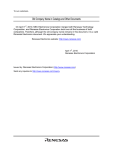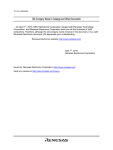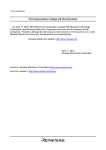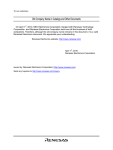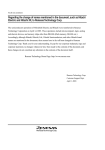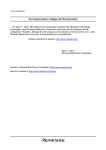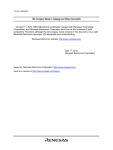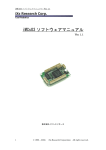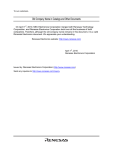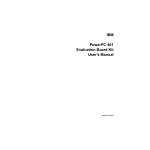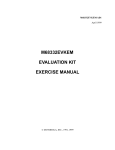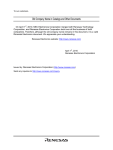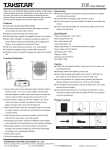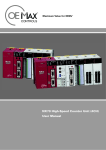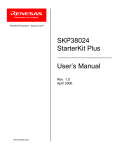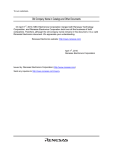Download H8 Family E10T Emulator Additional Document for User`s Manual
Transcript
To our customers, Old Company Name in Catalogs and Other Documents On April 1st, 2010, NEC Electronics Corporation merged with Renesas Technology Corporation, and Renesas Electronics Corporation took over all the business of both companies. Therefore, although the old company name remains in this document, it is a valid Renesas Electronics document. We appreciate your understanding. Renesas Electronics website: http://www.renesas.com April 1st, 2010 Renesas Electronics Corporation Issued by: Renesas Electronics Corporation (http://www.renesas.com) Send any inquiries to http://www.renesas.com/inquiry. Notice 1. 2. 3. 4. 5. 6. 7. All information included in this document is current as of the date this document is issued. Such information, however, is subject to change without any prior notice. Before purchasing or using any Renesas Electronics products listed herein, please confirm the latest product information with a Renesas Electronics sales office. Also, please pay regular and careful attention to additional and different information to be disclosed by Renesas Electronics such as that disclosed through our website. Renesas Electronics does not assume any liability for infringement of patents, copyrights, or other intellectual property rights of third parties by or arising from the use of Renesas Electronics products or technical information described in this document. No license, express, implied or otherwise, is granted hereby under any patents, copyrights or other intellectual property rights of Renesas Electronics or others. You should not alter, modify, copy, or otherwise misappropriate any Renesas Electronics product, whether in whole or in part. Descriptions of circuits, software and other related information in this document are provided only to illustrate the operation of semiconductor products and application examples. You are fully responsible for the incorporation of these circuits, software, and information in the design of your equipment. Renesas Electronics assumes no responsibility for any losses incurred by you or third parties arising from the use of these circuits, software, or information. When exporting the products or technology described in this document, you should comply with the applicable export control laws and regulations and follow the procedures required by such laws and regulations. You should not use Renesas Electronics products or the technology described in this document for any purpose relating to military applications or use by the military, including but not limited to the development of weapons of mass destruction. Renesas Electronics products and technology may not be used for or incorporated into any products or systems whose manufacture, use, or sale is prohibited under any applicable domestic or foreign laws or regulations. Renesas Electronics has used reasonable care in preparing the information included in this document, but Renesas Electronics does not warrant that such information is error free. Renesas Electronics assumes no liability whatsoever for any damages incurred by you resulting from errors in or omissions from the information included herein. Renesas Electronics products are classified according to the following three quality grades: “Standard”, “High Quality”, and “Specific”. The recommended applications for each Renesas Electronics product depends on the product’s quality grade, as indicated below. You must check the quality grade of each Renesas Electronics product before using it in a particular application. You may not use any Renesas Electronics product for any application categorized as “Specific” without the prior written consent of Renesas Electronics. Further, you may not use any Renesas Electronics product for any application for which it is not intended without the prior written consent of Renesas Electronics. Renesas Electronics shall not be in any way liable for any damages or losses incurred by you or third parties arising from the use of any Renesas Electronics product for an application categorized as “Specific” or for which the product is not intended where you have failed to obtain the prior written consent of Renesas Electronics. The quality grade of each Renesas Electronics product is “Standard” unless otherwise expressly specified in a Renesas Electronics data sheets or data books, etc. “Standard”: 8. 9. 10. 11. 12. Computers; office equipment; communications equipment; test and measurement equipment; audio and visual equipment; home electronic appliances; machine tools; personal electronic equipment; and industrial robots. “High Quality”: Transportation equipment (automobiles, trains, ships, etc.); traffic control systems; anti-disaster systems; anticrime systems; safety equipment; and medical equipment not specifically designed for life support. “Specific”: Aircraft; aerospace equipment; submersible repeaters; nuclear reactor control systems; medical equipment or systems for life support (e.g. artificial life support devices or systems), surgical implantations, or healthcare intervention (e.g. excision, etc.), and any other applications or purposes that pose a direct threat to human life. You should use the Renesas Electronics products described in this document within the range specified by Renesas Electronics, especially with respect to the maximum rating, operating supply voltage range, movement power voltage range, heat radiation characteristics, installation and other product characteristics. Renesas Electronics shall have no liability for malfunctions or damages arising out of the use of Renesas Electronics products beyond such specified ranges. Although Renesas Electronics endeavors to improve the quality and reliability of its products, semiconductor products have specific characteristics such as the occurrence of failure at a certain rate and malfunctions under certain use conditions. Further, Renesas Electronics products are not subject to radiation resistance design. Please be sure to implement safety measures to guard them against the possibility of physical injury, and injury or damage caused by fire in the event of the failure of a Renesas Electronics product, such as safety design for hardware and software including but not limited to redundancy, fire control and malfunction prevention, appropriate treatment for aging degradation or any other appropriate measures. Because the evaluation of microcomputer software alone is very difficult, please evaluate the safety of the final products or system manufactured by you. Please contact a Renesas Electronics sales office for details as to environmental matters such as the environmental compatibility of each Renesas Electronics product. Please use Renesas Electronics products in compliance with all applicable laws and regulations that regulate the inclusion or use of controlled substances, including without limitation, the EU RoHS Directive. Renesas Electronics assumes no liability for damages or losses occurring as a result of your noncompliance with applicable laws and regulations. This document may not be reproduced or duplicated, in any form, in whole or in part, without prior written consent of Renesas Electronics. Please contact a Renesas Electronics sales office if you have any questions regarding the information contained in this document or Renesas Electronics products, or if you have any other inquiries. (Note 1) “Renesas Electronics” as used in this document means Renesas Electronics Corporation and also includes its majorityowned subsidiaries. (Note 2) “Renesas Electronics product(s)” means any product developed or manufactured by or for Renesas Electronics. User’s Manual H8 Family E10T Emulator Additional Document for User’s Manual H8/3048F-ONE E10T HS3048BTCM01HE-U2 Renesas Microcomputer Development Environment System H8 Family / H8/300H Series Notes on Connecting the H8/3048F-ONE and H8/3029F Rev.2.0 2004.03 Cautions Keep safety first in your circuit designs! 1. Renesas Technology Corp. puts the maximum effort into making semiconductor products better and more reliable, but there is always the possibility that trouble may occur with them. Trouble with semiconductors may lead to personal injury, fire or property damage. Remember to give due consideration to safety when making your circuit designs, with appropriate measures such as (i) placement of substitutive, auxiliary circuits, (ii) use of nonflammable material or (iii) prevention against any malfunction or mishap. Notes regarding these materials 1. These materials are intended as a reference to assist our customers in the selection of the Renesas Technology Corp. product best suited to the customer's application; they do not convey any license under any intellectual property rights, or any other rights, belonging to Renesas Technology Corp. or a third party. 2. Renesas Technology Corp. assumes no responsibility for any damage, or infringement of any third-party's rights, originating in the use of any product data, diagrams, charts, programs, algorithms, or circuit application examples contained in these materials. 3. All information contained in these materials, including product data, diagrams, charts, programs and algorithms represents information on products at the time of publication of these materials, and are subject to change by Renesas Technology Corp. without notice due to product improvements or other reasons. It is therefore recommended that customers contact Renesas Technology Corp. or an authorized Renesas Technology Corp. product distributor for the latest product information before purchasing a product listed herein. The information described here may contain technical inaccuracies or typographical errors. Renesas Technology Corp. assumes no responsibility for any damage, liability, or other loss rising from these inaccuracies or errors. Please also pay attention to information published by Renesas Technology Corp. by various means, including the Renesas Technology Corp. Semiconductor home page (http://www.renesas.com). 4. When using any or all of the information contained in these materials, including product data, diagrams, charts, programs, and algorithms, please be sure to evaluate all information as a total system before making a final decision on the applicability of the information and products. Renesas Technology Corp. assumes no responsibility for any damage, liability or other loss resulting from the information contained herein. 5. Renesas Technology Corp. semiconductors are not designed or manufactured for use in a device or system that is used under circumstances in which human life is potentially at stake. Please contact Renesas Technology Corp. or an authorized Renesas Technology Corp. product distributor when considering the use of a product contained herein for any specific purposes, such as apparatus or systems for transportation, vehicular, medical, aerospace, nuclear, or undersea repeater use. 6. The prior written approval of Renesas Technology Corp. is necessary to reprint or reproduce in whole or in part these materials. 7. If these products or technologies are subject to the Japanese export control restrictions, they must be exported under a license from the Japanese government and cannot be imported into a country other than the approved destination. Any diversion or reexport contrary to the export control laws and regulations of Japan and/or the country of destination is prohibited. 8. Please contact Renesas Technology Corp. for further details on these materials or the products contained therein. Contents Section 1 Connecting the Emulator with the User System ............................... 1 1.1 1.2 1.3 1.4 Components of the Emulator ............................................................................................1 Connecting the E10T Emulator with the User System......................................................2 Pin Assignments of the E10T Connector ..........................................................................4 Example of Emulator Connection .....................................................................................5 Section 2 Specification of the E10T Emulator’s Software ............................... 11 2.1 2.2 Differences between the MCUs (H8/3048F-ONE and H8/3029F) and the Emulator .......11 The H8/3048F-ONE E10T Emulator Functions ...............................................................13 2.2.1 Emulator Driver Selection ...................................................................................13 2.2.2 Hardware Break Functions...................................................................................14 2.2.3 Notes on Setting the [Breakpoint] Dialog Box ....................................................15 2.2.4 Trace Function .....................................................................................................15 i ii Section 1 Connecting the Emulator with the User System 1.1 Components of the Emulator The H8/3048F-ONE E10T emulator supports the H8/3048F-ONE and H8/3029F (hereafter referred to as the MCU unless the description is specific to any of them). Table 1.1 lists the components of the emulator. Table 1.1 Components of the Emulator (HS3048BTCM01H or HS3048BTCI01H) Classification Component Hardware Appearance Card emulator HS3048BTCM01H (Model: HS0005TCM02H), HS3048BTCI01H (Model: HS0005TCI02H) Quantity Remarks 1 or HS3048BTCM01H (PCMCIA: 20-pin type): Depth: 85.6 mm, Width: 54.0 mm, Height: 5.0 mm, Mass: 28.0 g HS3048BTCI01H (PCI: 20-pin type): Depth: 122.0 mm, Width: 96.0 mm, Mass: 78.0 g User system interface cable 1 HS3048BTCM01H (PCMCIA: 20-pin type): Length: 80.0 cm, Mass: 46.0 g HS3048BTCI01H (PCI: 20-pin type): Length: 150.0 cm, Mass: 90.0 g Software H8/3048F-ONE E10T emulator setup program, H8 Family E10T Emulator User’s Manual, and Notes on Connecting the H8/3048F-ONE and H8/3029F 1 HS3048BTCM01SR, HS0005TCM01HJ, HS0005TCM01HE, HS3048BTCM01HJ-U2, and HS3048BTCM01HE-U2 (provided on a CD-R) 1 1.2 Connecting the E10T Emulator with the User System Before connecting an E10T emulator (hereafter referred to as emulator) with the user system, a connector must be installed in the user system so that an user system interface cable can be connected. When designing the user system, refer to the connector and recommended circuits shown in this manual. Before designing the user system, be sure to read the E10T emulator user’s manual and the hardware manual for related MCUs. Table 1.2 shows the recommended connector for the emulator. Table 1.2 Recommended Connector Type Number Manufacturer Specifications 2520-6002 3M Limited 20-pin straight type Connect pins 2, 4, 6, 8, 10, 12, 14, and 16 of the user system connector to GND firmly on the PCB. These pins are used as electrical GND and to monitor the connection of the user system connector. Note the pin assignments of the user system connector. User system interface cable Tab GND line H-UDI port connector Pin 2 User system GND connection Pin 1 User system Figure 1.1 Connecting the User System Interface Cable to the User System 2 Notes: 1. The pin number assignments of the 20-pin connector differ from those of the E10A emulator; however, the physical location is the same. 2. When designing the connector layout on the user board, do not place any components within 3 mm of the connector. 3. When the emulator is used in the writer mode, connect the emulator similarly to the user system. 3 1.3 Pin Assignments of the E10T Connector Figure 1.2 shows the pin assignments of the connector. Pin 1 mark Pin No. Signal 1 RES# 2 Vss 3 FWE 4 Vss 5 MD0 6 Vss 7 MD1 8 Vss 9 MD2 10 Vss 11 N.C. 12 Vss 13 N.C. 14 Vss 15 P91/TxD1 16 Vss 17 P93/RxD1 18 Vcc 19 P95/SCK1 20 Vcc Connector Pin 2 Pin 1 Pin 20 Pin 19 Top view Pin 1 mark Notes: 1. The symbol (#) means that the signal is active-low. 2. Vss (pin 2) detects connection or disconnection with the E10T user system. 3. Pin 20 is Vcc; however, it can be N.C. if an on-board flash writer (including the third party's product) is not used. Figure 1.2 Pin Assignments of the Connector 4 1.4 Example of Emulator Connection Figure 1.3 shows an example of emulator connection to the MCU. 20-pin connector with a 2.54-mm pitch (3M Limited: 2520-6002) Vcc Pulled up by 10 kΩ MCU 18 5 MD0 7 MD1 9 MD2 15 P91/TxD1 17 P93/RxD1 19 P95/SCK1 3 FWE 47 kΩ 1 RES# * User logic Vss 2, 4, 6, 8, 10, 12, 14, 16 E10T pin No. User system *Open-collector output buffer Figure 1.3 Example of Emulator Connection (Mode 7) 5 Notes: 1. P91, P93, and P95 are used by the emulator. Pull up and connect the emulator and MCU pins. MCU User system connector Vcc 10 k Pins 15, 17, and 19 P91, P93, P95 Figure 1.4 Connection of Emulator and MCU 2. The FWE signal is used for forced break control by the emulator. Connect the emulator and MCU pins directly. MCU User system connector FWE pin Pin 3 47 k Figure 1.5 Connection of Emulator and FWE Pin 3. The RES# pin is used by the emulator. Create the following circuit so that a reset input from the emulator can be accepted: Example of reset circuit Vcc User system connector User logic * MCU 10 k RES# pin Pin 1 *Open-collector output buffer Figure 1.6 Example of Reset Circuits 6 4. MD0 to MD2 pins are used by the emulator at power-on reset. Connect MD0 to MD2 pins as shown in figure 1.7. When MD2 and MD0 to MD1 pins are 1: User system connector MCU Vcc 10 k Pins 5, 7, and 9 MD0 to MD2 When MD0 to MD1 pins are 0: MCU User system connector Pins 5 and 7 MD0 to MD1 Figure 1.7 Example of Circuits for Operating Mode Setting Pins 5. Connect Vss and Vcc with the Vss and Vcc of the MCU, respectively. 6. Connect nothing with N.C. 7. The amount of voltage permitted to input to Vcc must be within the guaranteed range of the microcomputer. The H8/3048F-ONE has 4.5- to 5.5-V and 3.0- to 3.6-V input voltages. Use the correct input voltage depending on the microcomputer. The H8/3029F only has 3.0- to 3.6-V input voltage. Do not apply 4.5- to 5.5-V as the input to Vcc. 7 8. Figure 1.8 shows the interface circuit in the emulator. Use this figure as a reference to decide the pull-up resistance value. User system connector Emulator control circuit Vcc HD74LV125A 10 k x2 22 P95 22 HD74LV125A 10 k P93 22 HD74LVC244A 10 k x1 22 10 k x3 MD1 MD0 MD2 22 RES# 22 P91 22 Figure 1.8 Interface Circuit in the Emulator (Reference) 8 19 17 x2 22 HD74LV125A 18 FWE 7 5 9 1 15 3 9. When the MCU is connected to the emulator, the functions listed below cannot be used. Table 1.3 Pin Functions Not Available H8/3048F-ONE and H8/3029F P91, P93, and P95 TxD1, RxD1, and SCK1 FWE IRQ5# The symbol (#) means that the signal is active-low. 9 10 Section 2 Specification of the E10T Emulator’s Software 2.1 Differences between the MCUs (H8/3048F-ONE and H8/3029F) and the Emulator 1. The emulator supports the operating modes shown in table 2.1. Table 2.1 Supported Operating Mode MCU Name Mode H8/3048F-ONE 5, 6, and 7 H8/3029F 5 and 7 2. When the emulator system is initiated, it initializes the general registers and part of the control registers as shown in table 2.2. Table 2.2 Register Initial Values at Emulator Link Up Register Initial Value PC Reset vector value in the vector address table ER0 to ER6 Undefined ER7 (SP) (16-Mbyte expanded mode with on-chip ROM enabled) H8/3048F-ONE: H’FFFF10 H8/3029F: H’FFFF20 (Single-chip advanced mode) H8/3048F-ONE: H’FFF10 (1-Mbyte expanded mode with on-chip ROM enabled) H8/3048F-ONE: H’FFF10 H8/3029F: H’FFF20 CCR 1 for I mask, and others undefined 3. Low-Power Mode During a user program break, the CPU operating frequency is forced to φ for high-speed operation. 4. RES Signal The MCU signals are only valid during user program execution started with clicking the GO or STEP-type button. In command input wait state, the RES signal is not sent to the H8/3048F-ONE. 11 Note: Do not start user program execution or access the memory while control input signal (RES) is being low. A TIMEOUT error will occur. The error will also occur when (RES) is low during a break. 5. System Control Register In the emulator, the internal I/O registers can be accessed from the [IO] window. However, be careful when accessing the system control register. The emulator saves the register value of the system control register at a break and returns the value when the user program is executed. Since this is done during a break, do not rewrite the system control register in the [IO] window. 6. Memory Access during Emulation If the memory contents are referenced or modified during emulation, realtime emulation cannot be performed because the user program is temporarily halted. 7. The emulator communicates with the H8/3048F-ONE by using the P95/SCK1, P93/RxD1, P91/TxD1, RES, FWE, and MD2 to MD0 pins. These pins cannot be used, except for RES and MD2 to MD0 pins. 8. The power consumed by the MCU can reach several mA. This is because the user power supply drives one HD74LV125A to make the communication signal level match the usersystem power-supply voltage. The power consumed rises little during user program execution since the emulator does not perform communication; it rises more during a break. 9. The emulator uses a two-word stack pointer for values stored on a user program break. Therefore, the stack area must accept two-word addresses. 10. Refresh Controller and DMA Controller The emulator cannot debug the user program that uses the refresh controller or DMA controller. 11. Reading the MDCR Register in the Reset Exception Processing Be sure to read MDCR in the reset exception processing of the user program. 12. Initialization of the Internal I/O Register by Reset Function In the [GO] - [Reset CPU], [GO] - [Reset GO] and RESET commands, the following internal I/O registers are not initialized. Be sure to initialize them by the user program. System control: SYSCR, MSTCR, DIVCR Interrupt controller: ISCR, IER, ISR, IPRA, IPRB Bus controller: ABWCR, ASTCR, WCR, WCER, BRCR, CSCR Watchdog timer: TCSR, TCNT, RSTCSR Serial communication interface (channel 1): SMR, BRR, SCR, TDR, SSR, RDR 12 Flash memory: FLMCR1, FLMCR2, EBR, RAMCR D/A converter: DASTCR 13. Note on Using Port 9 P91, P93, and P95 of port 9 are used by the emulator. When the P9DDR register is written in the user program, set bits P91DDR, P93DDR, and P95DDR in that register as follows: P91DDR = 1 P93DDR = 0 P95DDR = 0 2.2 The H8/3048F-ONE E10T Emulator Functions Notes: 1. Do not use an MCU that has been used for debugging. 2.2.1 2. If the flash memory is rewritten many times, and the emulator is left for a few days, data may be lost due to retention problems. 3. If the flash memory is rewritten many times, the data will not be erased. If an error message is displayed, exchange the MCU for a new one. Emulator Driver Selection Table 2.3 shows drivers which can be selected in the [E10T Driver Details] dialog box. Table 2.3 Type Name and Driver Type Name Driver HS3048BTCM01H E10T PC Card Driver 2 HS3048BTCI01H E10T PCI Card Driver 2 13 2.2.2 Hardware Break Functions Hardware Break Conditions: In the emulator, conditions of Break Condition 1,2 can be set. Table 2.4 lists the items that can be specified. Table 2.4 Hardware Break Condition Specification Items Items Description Address bus condition Breaks when the MCU address bus value matches the specified value. Data bus condition Breaks when the MCU data bus value matches the specified value. Byte or word can be specified as the access data size. Read or write condition Breaks in the read or write cycle. Table 2.5 lists the combinations of conditions that can be set in the [Break condition 1] and [Break condition 2] dialog boxes. Table 2.5 Conditions Set in [Break condition 1] and [Break condition 2] Dialog Boxes Condition Dialog Box Address Bus Condition O O [Break condition 1] [Break condition 2] Data Condition O x Read or Write Condition O x Note: O: Can be set by checking the radio button in the dialog box. X: Cannot be set in the dialog box. Table 2.6 lists the combinations of conditions that can be set by the BREAKCONDITION_SET command. Table 2.6 Conditions Set by BREAKCONDITION_SET Command Condition Channel Break condition 1 Break condition 2 Address Bus Condition (<addropt> option) O O Data Condition (<dataopt> option) O x Note: O: Can be set by the BREAKCONDITION_SET command. X: Cannot be set by the BREAKCONDITION_SET command. 14 Read or Write Condition (<r/wopt> option) O x Notes on Setting the Break Condition: 1. When [Go to cursor], [Step In], [Step Over], or [Step Out] is selected, the settings of Break Condition 1 are disabled. 2. Setting of Break Condition 1 is disabled when an instruction to which a BREAKPOINT has been set is executed. 3. When step over function is used, the settings of BREAKPOINT and Break Condition 1 are disabled. 4. The address bus condition of Break Condition 2 or channel 2 of the Breakcondition_set command is satisfied only for the instruction prefetch address. The condition is not satisfied for the address bus value other than the instruction prefetch address. In this case, use Break Condition 1 or channel 1 of the Breakcondition_set command. 2.2.3 Notes on Setting the [Breakpoint] Dialog Box 1. When an odd address is set, the address is rounded down to an even address. 2. A BREAKPOINT is accomplished by replacing instructions. Accordingly, it can be set only to the flash memory or RAM area. However, a software break cannot be set to the following addresses: • An area other than flash memory or RAM • An instruction in which Break Condition 1 is satisfied 3. During step operation, a BREAKPOINT is disabled. 4. A condition set at Break Condition 1 is disabled immediately after starting execution when an instruction at a BREAKPOINT is executed. A break does not occur even if a condition of Break Condition 1 is satisfied immediately after starting the execution. 5. When execution resumes from the breakpoint address after the program execution stops at the BREAKPOINT, single-step operation is performed at the address before execution resumes. Therefore, realtime operation cannot be performed. 6. Settings of BREAKPOINT and Break Condition 1 are invalid while the STEP OVER function is being used. 2.2.4 Trace Function The trace function in the emulator uses the branch-instruction trace function in the MCU. It displays the branch-source address or the mnemonic, and operand can be acquired in realtime. 15 16 H8 Family E10T Emulator Additional Document for User's Manual Notes on Connecting the H8/3048F-ONE and H8/3029F Publication Date: Rev.1.00, November 25, 2003 Rev.2.00, March 1, 2004 Published by: Sales Strategic Planning Div. Renesas Technology Corp. Edited by: Technical Documentation & Information Department Renesas Kodaira Semiconductor Co., Ltd. 2003, 2004 Renesas Technology Corp. All rights reserved. Printed in Japan. H8 Family E10T Emulator Additional Document for User’s Manual 1753, Shimonumabe, Nakahara-ku, Kawasaki-shi, Kanagawa 211-8668 Japan REJ10B0113-0200H


























